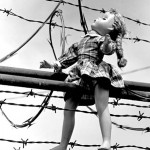The data are especially vexing because girls aren’t committing more crimes or suddenly becoming more violent; they account for only 9% of the murders committed by juveniles, and they are far more likely than boys to be arrested for non-violent crimes. Experts say the increase among girls is largely due to more aggressive enforcement of minor offenses — offenses that are often rooted in the experience of abuse or trauma.
In 2012, the most recent year that data was reported by the federal government, girls represented 76 %of the juveniles arrested for prostitution and 38% of the minors involved in domestic offenses, according to the Department of Justice’s Office of Juvenile Justice and Delinquency Prevention, which tracks minors’ involvement in the penal system.
Many girls are also arrested for offenses that wouldn’t even be considered crimes if they were adults, such as underage drinking (40%) or missing curfew (29%). Researchers said that these behaviors are often symptoms of abuse and shouldn’t be criminalized.
Francine Sherman, the report’s author and a professor at Boston College Law School wrote:
The current justice system responds to behaviors caused by trauma and abuse with punishment and fails to offer girls effective solutions and a healthy path forward.
Girls in the juvenile justice system continue to experience abuse at unprecedented rates. According to a report by the DOJ last year, 84% are victims of family violence and 41% have suffered physical abuse. They are 4.4 times more likely than boys to be sexually assaulted before their arrests.
Incarcerated girls also suffer from mental illness at higher rates than boys. In Ohio, for instance, 96% of girls in juvenile jails and prisons are receiving treatment for mental disorders, as opposed to 44% of the boys.
Perversely, experts say, arrests of girls often arise from situations in which they are the victims — of human trafficking, of physical or emotional abuse, or other coercion.
Dana Shoenberg, a visiting professor at the University of Baltimore School of Law who has done extensive research on gender relations in the justice system, says:
Girls who end up in trouble with the court system often have a complex trauma history that caused them to have mental health needs. There is a clear relationship between those two. Girls with mental health conditions often face more challenges than boys when they get locked up.
Sometimes, the people in juvenile facilities don’t have the experience or have the training to deal with girls and their trauma. The programming is just not set up to meet the needs of incarcerated girls.
The story of Danielle Hicks-Best, published in the Washington Post last March, offers a glimpse into how ostensible victims can be further victimized by the criminal system. Danielle was 11 when she told police she had been raped twice. Despite medical evidence that showed signs of sexual assault, police concluded her sexual encounter was consensual — even though she was well below the age of consent — and charged her with filing a false report. She pled guilty to the charges and spent several painful years in and out of detention and treatment.
The authors of “The Sexual Abuse to Prison Pipeline: The Girls’ Story,” another 2015 study by several U.S. organizations that advocate for human rights, wrote
When law enforcement views girls as perpetrators, and when their cases are not dismissed or diverted but sent deeper into the justice system, the cost is twofold: girls’ abusers are shielded from accountability, and the trauma that is the underlying cause of the behavior is not addressed.
It is a continuation of the phenomenon we see with school offenses — rather than addressing the environmental issue, they are blaming the kids, in this case the girls. They are being taken out of their homes and pushed in the criminal justice system when this is a family issue that should be handled by a family and child protection system.
The juvenile justice system will be fixed when law enforcement officers have a better understanding of the girls they are arresting and the trauma they have experienced. Trauma is a driving force. You are putting girls in the system that are traumatized and the response to trauma is often misunderstood.










